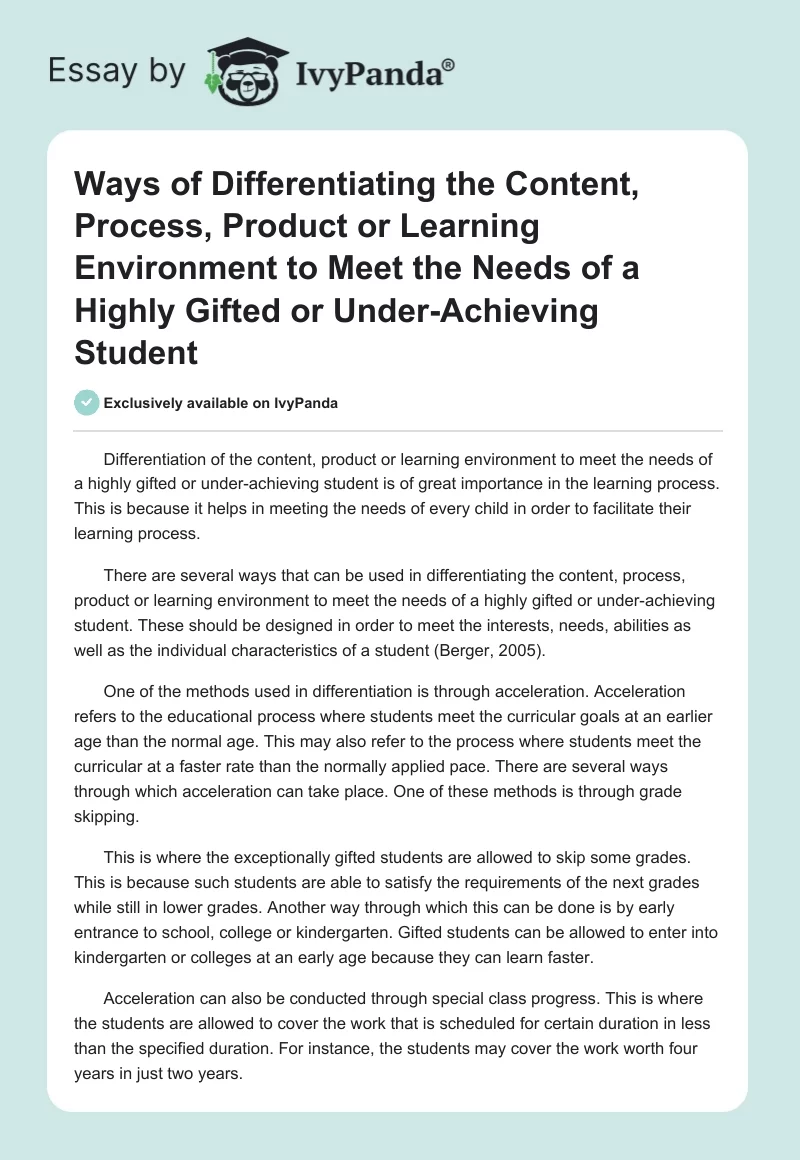Differentiation of the content, product or learning environment to meet the needs of a highly gifted or under-achieving student is of great importance in the learning process. This is because it helps in meeting the needs of every child in order to facilitate their learning process.
There are several ways that can be used in differentiating the content, process, product or learning environment to meet the needs of a highly gifted or under-achieving student. These should be designed in order to meet the interests, needs, abilities as well as the individual characteristics of a student (Berger, 2005).
One of the methods used in differentiation is through acceleration. Acceleration refers to the educational process where students meet the curricular goals at an earlier age than the normal age. This may also refer to the process where students meet the curricular at a faster rate than the normally applied pace. There are several ways through which acceleration can take place. One of these methods is through grade skipping.
This is where the exceptionally gifted students are allowed to skip some grades. This is because such students are able to satisfy the requirements of the next grades while still in lower grades. Another way through which this can be done is by early entrance to school, college or kindergarten. Gifted students can be allowed to enter into kindergarten or colleges at an early age because they can learn faster.
Acceleration can also be conducted through special class progress. This is where the students are allowed to cover the work that is scheduled for certain duration in less than the specified duration. For instance, the students may cover the work worth four years in just two years.
Through acceleration, it becomes possible to avoid boredom of the gifted student through repetition of same things. This exercise also enables the students to mix with other intellectual peers hence sharing knowledge and motivating each other (Feinstein, 2006). Finally, a student can be molded through mentorship. This is where a student is guided by an expert in a particular field who helps them in learning in a certain area.
The next method of differentiation is through modification. For instance, it is necessary to modify the content accordingly in order to meet the needs of each child. Through modification, the curricular can be shaped in such a way that it suits each group of the students.
Another method of differentiation is through enrichment. Enrichment activities refer to those activities that are designed to broaden and develop children’s experiences without necessarily going into much depth enrichment activities (Berger, 2005).
The aspect of enrichment touches the issues relating to curriculum as well as the delivery of the program. Through enrichment, the curriculum is modified or has some additions in order to cater for the needs of the gifted students.
Extension is another method through which the content can be differentiated. According to Davies (2002), this involves the deepening of the curricular content.
Extension involves the incorporation of the activities that allows the students to stretch their understanding as well as their appreciation of a particular topic being taught by their teachers. The extension activities can range from provision of the learning centers, summer schools; problem solving and resource based learning (Feinstein, 2006).
Over the past, teachers have been using streaming in differentiating the curricular content. This takes place through a process where different groups in the same classroom worked on differing curriculum content based on the level of complexity (Davies, 2002).
These grouping divided students depending on their ability to get ideas. Through this process, students are divided into three groups. These include the slow group, the average group and the medium group. Each of these groups is then subjected to appropriate curriculum.
The teachers can also modify the curricular process for the gifted students through modification of the thought process required (Davies, 2002). Through these practices, teachers can help the students in using a higher order of thinking skills as well as low order of thinking accordingly. In the process, the gifted students are able to acquire the knowledge and use this knowledge effectively.
Another method of differentiation is by providing negotiation and choice for the student. Through negotiation, curriculum content can be easily enriched for the gifted students (Berger, 2005). This process also assists the teachers to understand their thoughts and their understanding of various aspects. Negotiation with the gifted students also helps them to think divergently in their efforts to plan and propose the necessary changes.
Motivation also plays a significant role in the education of a gifted student. According to Davies (2002), motivation can be viewed as the process by which the gifted students involve themselves and engage in the learning activities.
The level of student engagement is necessary as it can determine their success to some extent. In other words, those students who fully participated in the curriculum are mostly probably going to record a high level of performance.
In conclusion, this discussion has clearly described the ways of differentiating the content, process, product or learning environment to meet the needs of a highly gifted or under-achieving student. These practices enable different kinds of students in their learning process by achieving and using their knowledge effectively.
Reference List
Berger, S. (2005). Differentiating Curriculum for Gifted Students. Davidson Institute for Talent Development. Web.
Davies, F. (2002). Practices Employed By Participating Teachers to Differentiate The Curriculum For The Gifted Students In Their Class. Web.
Feinstein, S. (2006). The Praeger Handbook of Learning and the Brain. U.S.A.: Greenwood Publishing Group.


